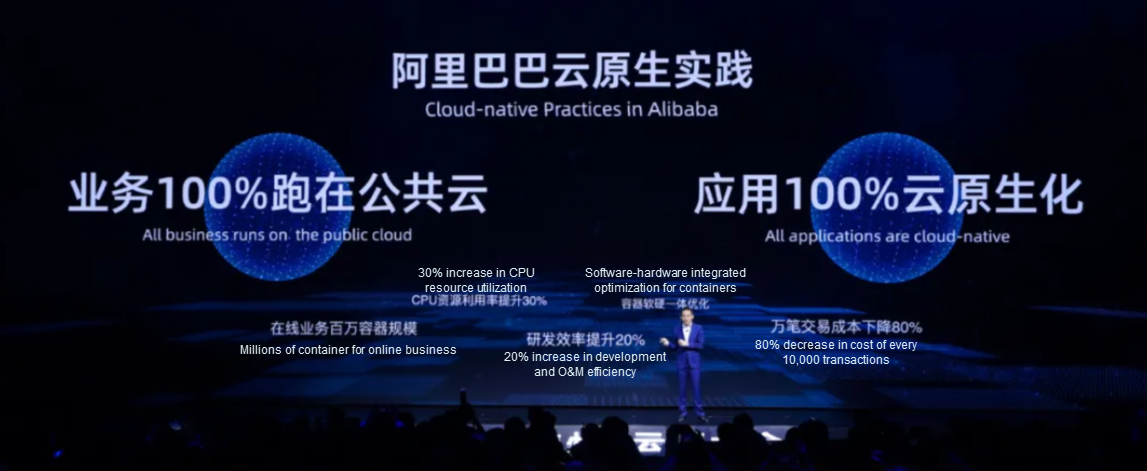Watch the replay of the Apsara Conference 2021 at this link!
At the 2021 Apsara Conference in Hangzhou, Zhang Jianfeng, President of Alibaba Cloud Intelligence, explained a brand-new world on the cloud for the first time, with the theme of Deep in the Cloud, a Brand-New World.
"A new computing system with the cloud as the core is taking shape. With the further integration of cloud and network technologies, computing will further migrate to the cloud in the future for both enterprises and individuals," Zhang Jianfeng said.
During the conference, Zhang mentioned cloud-native many times throughout his speech.
Today, thousands of industries are embracing cloud computing and cloud-native for digital scale-up, and the connotation of cloud-native is also being enriched constantly. Initially, cloud-native technologies emerged to help enterprises build loosely coupled systems, featuring elastic scaling, fault tolerance, and ease of management and observation. Representative technologies include containers, Kubernetes, microservices, service mesh, and DevOps. Cloud-native is a collection of technologies at the application layer.
The advantage of cloud computing is resource pooling. Its benefit is the intensive management on a large scale, making elasticity and distribution ubiquitous. Only when cloud-native technology is combined with the cloud can it exert its power. The combination of cloud-native technology and cloud computing forms cloud-native products. Their common features are software-hardware integrated optimization, API-based O&M management, elastic on-demand acquisition, and product as a service.
Alibaba Cloud provides hundreds of cloud-native products, such as container services, cloud-native big data, cloud-native middleware, cloud-native databases, ECS Bare Metal Instance, and Function Compute. All of these simplify the development and construction of business applications significantly. According to industry analysis, more than 90% of enterprises have already been using cloud-native products for application construction.
Cloud-native is making changes to all-cloud development. Developers are changing from off-cloud development to on-cloud development for higher productivity. Industry analysis from authoritative organizations shows that by the end of 2021, 68% of organizations and institutions will use containers in their production, 75% of enterprise software will be constructed with low-code technologies, and 25% of developers will use Serverless technologies. Cloud-native is opening an era of on-cloud development and all-cloud development.
Alibaba Cloud provides comprehensive tools, products, and open-source projects to empower developers, cope with, and lead any changes. For the entire technology community, Alibaba Cloud gives back its technological achievements through years of research to the world's top foundations, such as the Openatom Foundation, Apache Foundation, and CNCF. Alibaba Cloud is committed to better promoting the healthy and sound development of the entire technology ecosystem. Alibaba Cloud has a total of more than 2,700 open-source projects on GitHub, covering big data, cloud computing, AI, middleware, containers, Serverless, and other realms. It also has 30,000 contributors and over 1.11 million GitHub Stars, ranking as the top open-source community in China in terms of the contribution to GitHub.

Among them, some open-source projects have become the standard in this realm. For instance, Dubbo has become the most influential and widely-used open-source microservice framework in China. RocketMQ is the first top-level Apache project as middleware and standard in the domestic message realm. Flink project is the most popular and influential project in the realm of big data stream processing. KubeVela is the first open application architecture standard for cloud computing in the industry. PolarDB continues to lead in the database realm.
Alibaba Cloud has built an open and standard technology system to serve developers worldwide. If developers want to build a complete application based on open-source, they can find a solution in the open-source ecosystem of Alibaba Cloud. Today, Alibaba Cloud's open-source projects serve five million developers worldwide and have a large number of model enterprise clients, such as iQIYI, Huya, and Ping An Technology. At the same time, Alibaba Cloud is also a beneficiary of open-source. As a large number of cloud-native open-source projects emerge, the open-source community has become a center of technology innovation, making cloud computing more standardized, transparent, open, easy to use, and accessible.
Alibaba Group is also a beneficiary of cloud-native, enjoying the technological dividend of cloud computing through cloud-native.

Alibaba has implemented the world's largest cloud-native practice, with all businesses on the public cloud and all applications being cloud-native. Based on the software-hardware integrated optimization of containers, its online business deploys over one million containers. It brings the technical value of a 30% increase in CPU resource utilization, an 80% decrease in the cost of every 10,000 transactions, and a 20% increase in development and O&M efficiency. It has created greater social value by capturing cloud computing dividends and seizing business opportunities.
Seven Major Technological Innovations and Breakthroughs of Alibaba Cloud in the Serverless Field

1,079 posts | 265 followers
FollowAlibaba Developer - July 13, 2021
Alibaba Clouder - March 2, 2021
Alibaba Developer - January 5, 2022
Alibaba Cloud New Products - November 10, 2020
Alibaba EMR - August 24, 2021
Alibaba Cloud Native Community - December 16, 2021

1,079 posts | 265 followers
Follow Bastionhost
Bastionhost
A unified, efficient, and secure platform that provides cloud-based O&M, access control, and operation audit.
Learn More Managed Service for Grafana
Managed Service for Grafana
Managed Service for Grafana displays a large amount of data in real time to provide an overview of business and O&M monitoring.
Learn More Hybrid Cloud Solution
Hybrid Cloud Solution
Highly reliable and secure deployment solutions for enterprises to fully experience the unique benefits of the hybrid cloud
Learn More Local Public Cloud Solution
Local Public Cloud Solution
This solution helps Internet Data Center (IDC) operators and telecommunication operators build a local public cloud from scratch.
Learn MoreMore Posts by Alibaba Cloud Community